Outsourcing to Czechia

How much does it cost to hire developers in Czechia?
Dec 2nd 25 - by Devico Team
Find out how much it costs to hire software developers in Czechia in 2025. Compare hourly rates, roles, and factors that impact pricing.
Hire
Hire by role
Hire Front-end developers
Hire Back-end developers
Hire Full-stack developers
Hire Android developers
Hire iOS developers
Hire Mobile developers
Hire AI engineers
Hire ML engineers
Hire Automation QA engineers
Hire Blockchain developers
Hire Data engineers
Hire Cloud engineers
Hire by skill
Hire JavaScript developers
Hire TypeScript developers
Hire Ruby on Rails developers
Hire React Native developers
Hire Flutter developers
Hire Golang developers
Hire React.js developers
Hire Python developers
Hire PHP developers
Hire .NET developers
Hire Java developers
Hire Laravel developers

EOR
June 28, 2024 - by Devico Team
Summarize with:
What if we say that there is a much simpler way to hire skilled staff globally without ripping off the budget? That's exactly how the employer of record (EOR) works.
EOR is a third-party organization that legally employs staff on behalf of another business and handles all compliance, payroll, and HR responsibilities in a particular jurisdiction. As we mentioned, EOR employment is especially beneficial for companies aiming at global expansion.
The popularity of employers of record bears witness to the advantageous opportunities they bring. Just compare the time for establishing a local entity (and the amount needed for that) with EOR/PEO services.
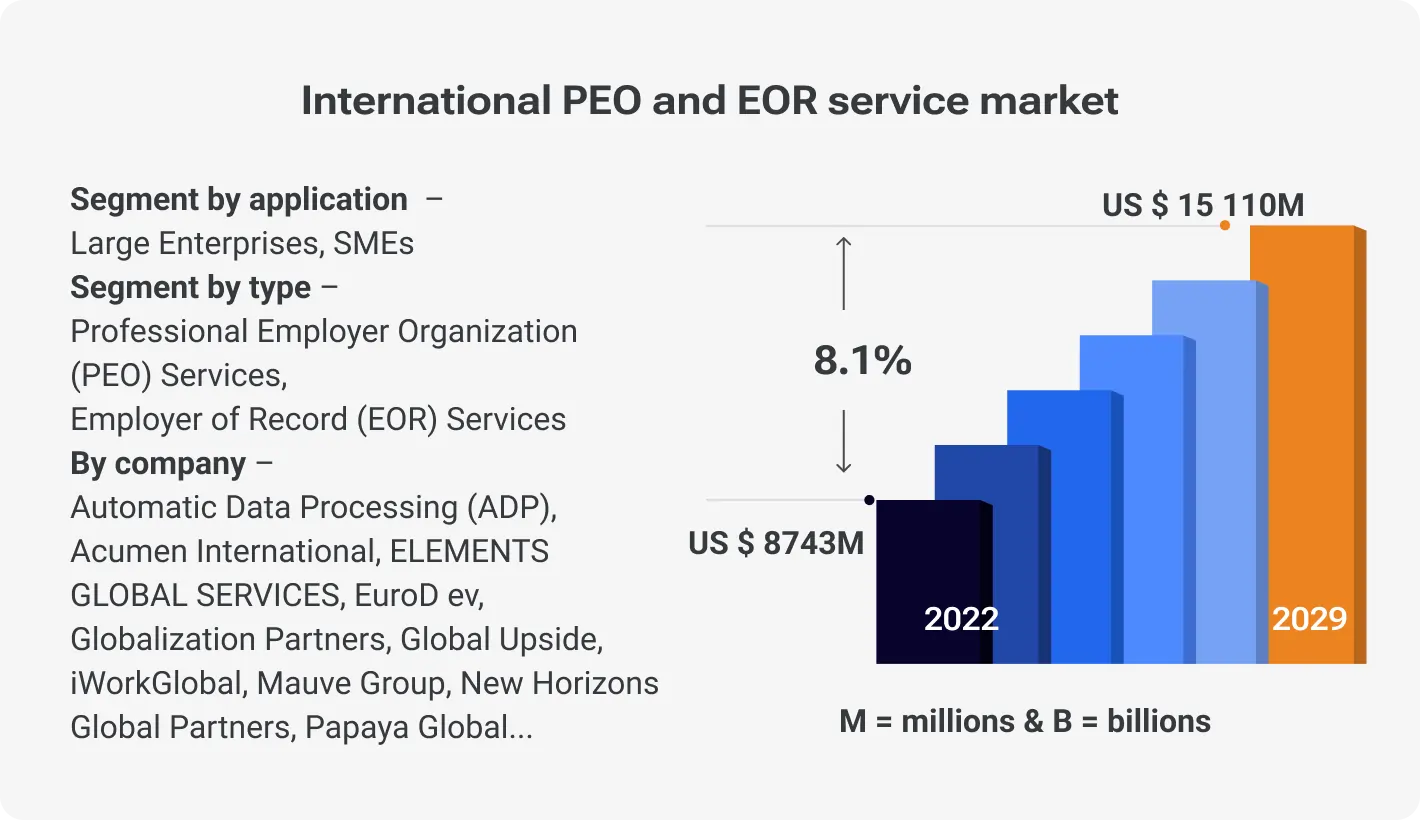
According to the CFO of Globalization Partners, it takes up to 12 months on average just to establish a foothold in a new market. And setting up an entity in Spain (for instance) will cost you USD 60K-USD 120K. Moreover, according to a sector review by Delancey Street Partners, the PEO/EOR industry has seen substantial growth — the global market will reach USD 151.2 billion in capitalization.
So, how does the EOR model differ from traditional setups? In a nutshell, you become the client, and the EOR handles payroll processing, taxes, benefits administration, and local employment compliance, freeing you to focus on what matters most — building a thriving global team.
Now, let's dig deeper into the step-by-step process of implementing the EOR model in your business.
We got the ABCs on what is an EOR. One more time — it’s really a game-changer for businesses looking to scale their operations and build an A-class team. Now, it’s time to list the leg-ups employer of record can offer to you.
Your accountants must have a knack for multitasking and an ideal memory to handle payroll across different countries. Due to varying tax systems and employment laws, this could turn into a burden. EOR simplifies this process by centralizing payroll operations under one standard system. This way, it’s more likely your foreign employees will be paid timely. As a consequence — reduction of administrative overhead and minimum errors associated with manual processing.
One of the biggest challenges of global expansion is adhering to local labor laws, which can vary significantly from one country to another.
If you don’t take it seriously enough, you could take a huge penalty. Don’t buy it? Listen to Uber Technologies. In 2022, a group of about 1,330 drivers settled their labor dispute on being misclassified as contractors rather than employees. This turned into a USD 8.4M fine for Uber.
An EOR has the expertise to navigate such issues, ensuring that your business remains compliant and avoids potential fines and legal issues. This peace of mind allows companies to focus on their core business activities without the constant worry of legal repercussions.
Another example. A US-based tech company used an EOR to get a leg-up in establishing an entry into the German market. The EOR handled all local employment tasks, and the client company focused on strategic growth and product development. As a result, a 50% increase in market reach within six months.
Metaphorically speaking, an EOR model is a door to a global talent pool. You're no longer limited by geographical boundaries — you can hire the best and brightest minds no matter where they're located. This enhances your ability to attract diverse skill sets and build a well-rounded, high-performing team.
The EOR model can significantly reduce your overall employment costs. You avoid the need to set up legal entities in each new country, and the EOR often offers economies of scale for payroll processing and administration. This translates into increased efficiency and more resources you can reinvest in core business functions.
For example, Tesco, a retail giant, expanded its operations into Asia using an EOR. In Britain, Tesco has nearly a 30% market share, and expansion into Asia made them the 7th most selling retailer in the world. As this strategy enabled the rapid setup of their stores, compliant with local employment standards, they reduced HR overhead by about 30% and accelerated launch timelines.
Moreover, according to The Hackett Group, companies that utilize EOR services usually achieve significant cost savings on international payroll and HR administration.
Global expansion is only one (yet probably the most desirable) strategy for growth, but it also has its flaws and pitfalls. Understanding this can help you better prepare and leverage an EOR business effectively. Let’s run through common hurdles and strategic solutions for this matter.
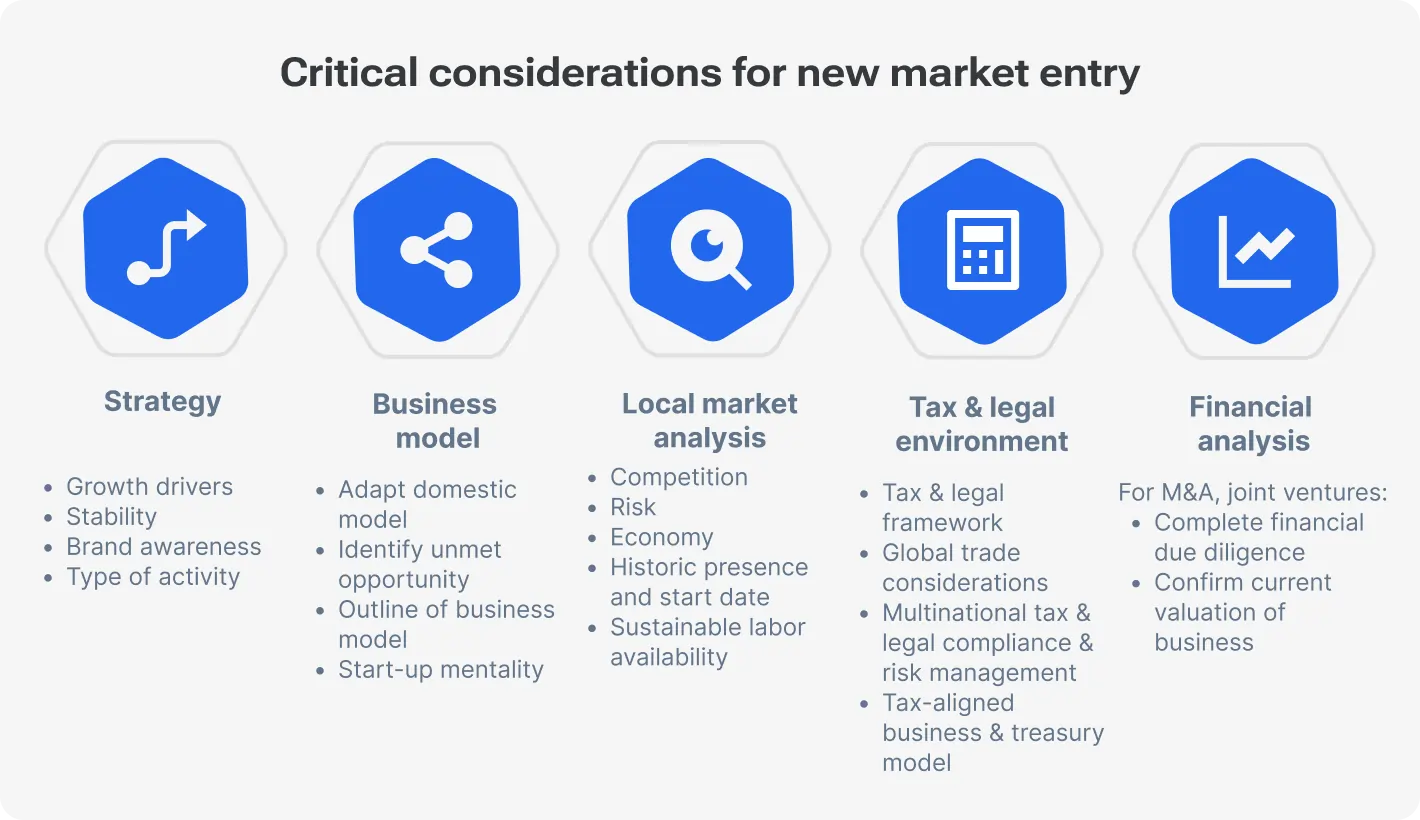
Navigating regulatory compliance: Compliance with local labor laws and regulations is one of the foremost challenges in global business expansion. Deloitte conducted a survey and found that the lion’s share of companies cited regulatory compliance as their top challenge when entering new markets. This includes everything from understanding local employment laws to adhering to tax obligations.
Bridging cultural differences: When you “blend” specialists from different countries, misunderstandings are almost inevitable. As a consequence — operational inefficiency. The Economist Intelligence Unit found that 90% of executives (68 countries covered) find cross-cultural management their biggest challenge in global expansion. Nothing groundbreaking: cultural differences affect team dynamics, employee engagement, and even customer interactions.
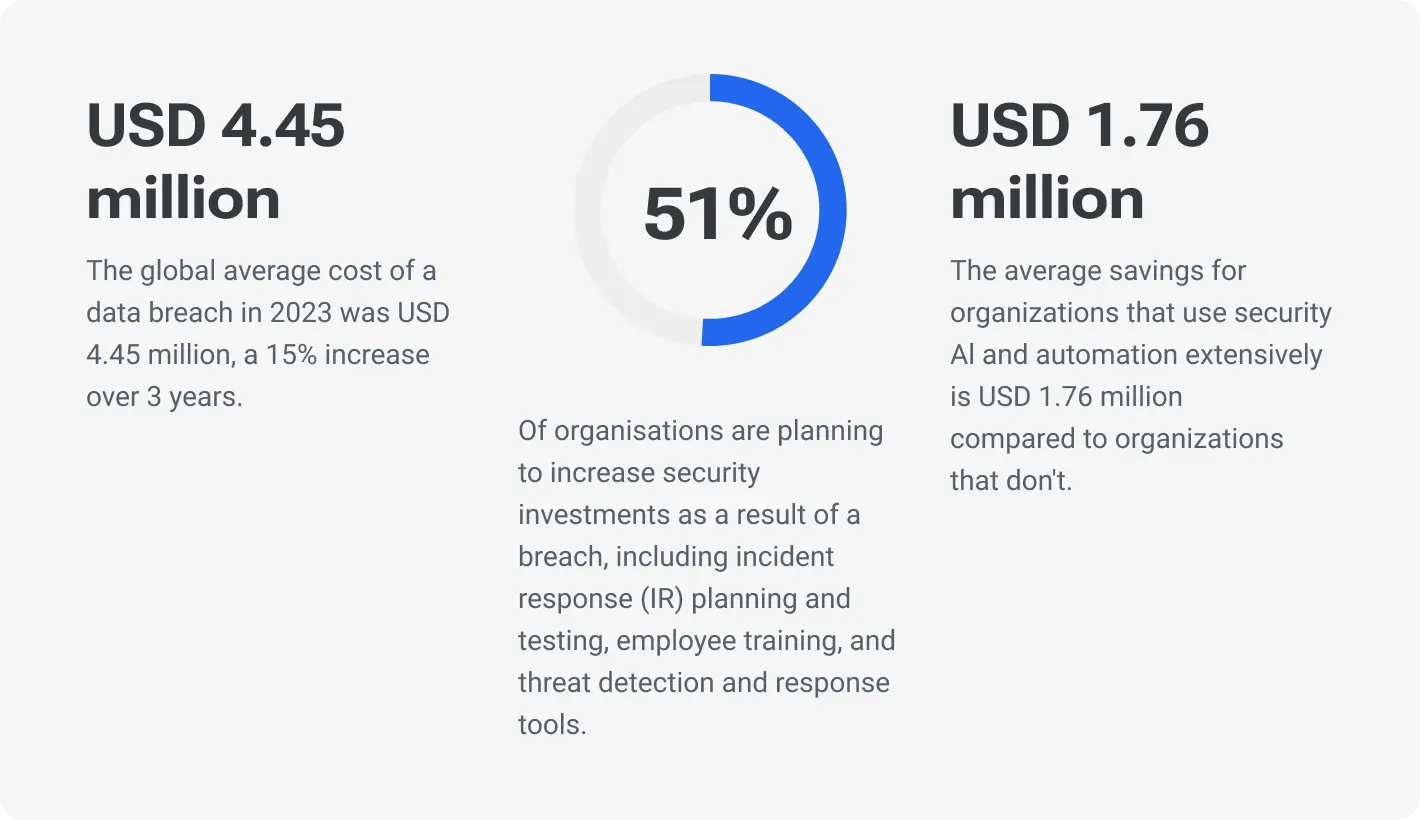
Ensuring data security: As businesses expand, you must also scale your data security measures to protect sensitive information across borders. The 2023 IBM Security Report states that the average cost of a data breach globally was USD 4.45 million.
Integration with Existing Systems: Integrating EOR services with your existing HR and payroll systems can bring about unnecessary hassle.
Employee misclassification: Misclassifying employees and contractors under an EOR arrangement can lead to serious legal and financial consequences. Recall the Uber case from the very beginning of this article. We’re 100% sure you don’t want to get fined.
Loss of employer branding: Relying on an EOR can sometimes distance a brand from its employees, potentially impacting employer branding. However, such a problem often pops up when partnering with renowned ERO providers with a strong brand like Deel.
Generally, we’ve already listed the prior strategies. Think over the mentioned cases if you have a serious intention to expand your company.
Also, make sure you have gone through all 101 rules. Start by conducting a thorough risk assessment for each country of operation to understand specific compliance needs and cultural factors. Partner with a seasoned EOR with robust local knowledge and a strong compliance track record. Regularly train your teams on regulatory and cultural nuances. All these steps prevent costly misunderstandings and compliance violations.
The right EOR company can make a significant difference in how effectively you can navigate all the mentioned hurdles.
To significantly streamline your international HR operations, take a look at this practical guide on how to seamlessly integrate an EOR model into your business. A strategic approach, broken down into clear and actionable steps — to your attention.
Hit the ground running by clearly defining what you aim to achieve with an EOR. Answer a couple of questions:
What new international markets do you intend to enter?
Do you need help managing remote teams across different jurisdictions?
What kind of support do you need?
Conducting a detailed needs assessment helps align your EOR strategy with your business objectives.
Action: Hold a brainstorming session with your leadership team to define your goals for global expansion. Consider factors like target markets, skill sets needed, and projected growth. Use SWOT analysis to identify strengths, weaknesses, opportunities, and threats related to global expansion. This will help you tailor your approach to using an EOR effectively.
Choosing an EOR partner is crucial. Look for providers with strong expertise in the specific countries where you plan to operate. They should have robust compliance track records and extensive local knowledge.
Action: Don't be afraid to ask. Request detailed proposals from shortlisted EORs and schedule consultations to discuss their pricing structures, service offerings, and compliance expertise. Check industry reviews and gather feedback from current clients to gauge the reliability and performance of potential EOR providers. Explore G2 Crowd, Clutch, or Trustpilot — they can offer valuable insights.
Transparency is key during any significant organizational change. Ensure that you communicate clearly with your employees about what the EOR transition means for them, particularly in terms of payroll, benefits, and their day-to-day roles.
Action: For this reason, a town hall meeting can help. As an alternative, create a comprehensive FAQ file to address employee concerns. Such steps with HR will help address employee concerns and explain the benefits and changes coming with the EOR model.
Once you’ve chosen your EOR, work closely with them to integrate their services with your existing HR systems. This involves aligning your payroll schedules, benefits plans, and HR policies with the EOR’s systems to ensure legal compliance and operational harmony.
Action: Leverage project management tools (Jira, Asana, Trello, etc.) to track the implementation process. Create a clear timeline with actionable tasks assigned to each team involved. Don’t forget to implement HR management software like BambooHR or Zenefits, which are designed to help integrate new HR processes and streamline the transition to an EOR setup.
Continuous monitoring and feedback: Regularly review the performance of your EOR arrangement. Seek feedback from employees and managers about how the change is impacting their work. Continuous monitoring allows you to quickly address any issues and make adjustments as needed.
Legal and compliance updates: Stay updated on legal changes in the countries where you operate. Regular consultations with legal experts can help you remain compliant under the EOR model.
Employee engagement: Keep your workforce engaged through regular updates and involvement in the transition process. This helps maintain morale and productivity.
With careful planning, the right partner, and effective communication, you can pull off this challenge.
Implementing an Employer of Record model is a strategic move. So, all further steps are determined by exactly your strategic vision and your goals. But how can you tell if it's truly paying off? Haters will say it does not. However, we can tip you off on how to measure the success of your EOR implementation to make it work for you. In addition, we listed the most important key performance indicators (KPIs) to keep an eye on.
Cost reduction is one of the most tangible benefits of implementing an EOR. To effectively measure this, track the total cost of operations before and after EOR implementation.
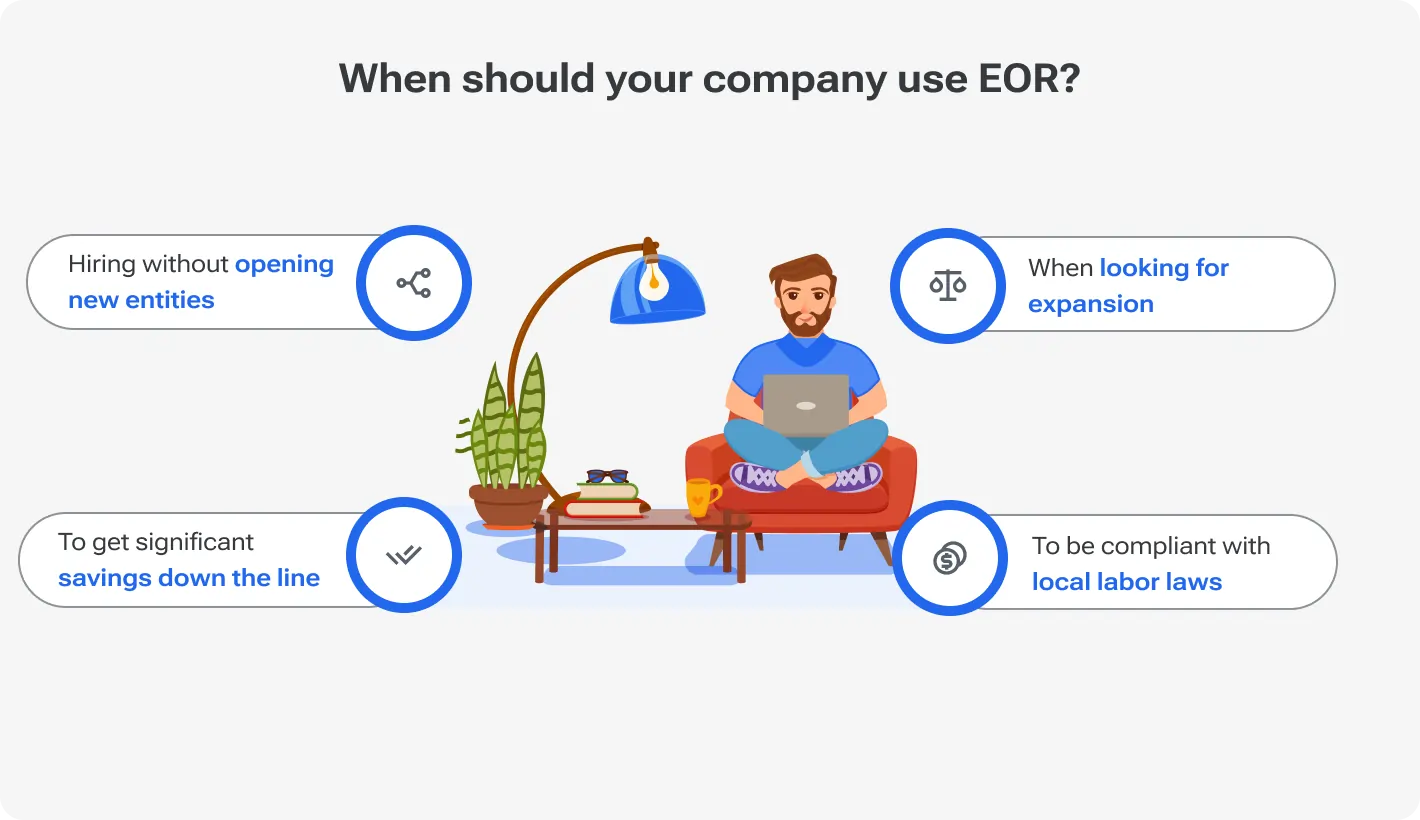
Efficiency in processes is another critical area that impacts your business directly. Speed and ease of entering new markets, the administrative load on your existing team — all these issues don’t make any sense if related tasks are performed half-heartedly.
Employee satisfaction can make or break your success. Happy employees are typically more productive and engaged. At the same time, highly engaged teams bring about a 21% profit increase.
Gauge the employee Net Promoter Score (eNPS) to find out how loyal your employees are and their willingness to recommend your company as a great place to work. A positive eNPS after transitioning to the EOR model indicates employee satisfaction with the new structure.
Nonetheless, don't rely solely on surveys. Conduct exit interviews with departing employees (if possible) to uncover any potential concerns related to the EOR model. Proactive communication and addressing team members' feedback are crucial for retention.
Someone may say that KPIs are obsolete. We parry: any tool is obsolete in today's fast-tempo world. The main thing is the relevant usage. So, to comprehensively evaluate the effectiveness of the EOR model, KPIs are a great “tool”. Consider some of these:
Operational cost per employee: Tracks the cost effectiveness of using an EOR versus in-house management.
Legal compliance hit rate: Measures the success rate in adhering to local employment laws, a critical aspect often missed until penalties occur.
Employee turnover rate: When this metric remains high, it may indicate that your EOR can’t handle payroll or benefits properly, and your team may not be satisfied with management.
Advanced analytics: Beyond basic tracking, use data analytics platforms like Tableau or Microsoft Power BI to visualize and analyze these KPIs. This move shows correlations between EOR implementation and business outcomes that are not evident through simple tracking.
Keep these metrics in check, and you will validate the success of your EOR implementation and continuously refine your strategy. Yet, the ultimate goal of using an EOR is not just to save money or expand swiftly but to create a sustainable, efficient, and happy workforce.
The current business landscape is changing faster than ever. What are the upcoming trends shaping the future of EOR employment services, and what tools can organizations use to stay competitive and culturally aligned?
You definitely heard about Swedish audio streaming giant Spotify. But have you known the company has pioneered a flexible work model called "Work from Anywhere"? Employees choose whether they want to work in the office, fully remotely, or in a coworking space.
Spotify manages this global policy through EOR which handles diverse employment laws and tax regulations. This way, streaming companies seamless workforce management across multiple jurisdictions. Integrating EOR models into broader corporate culture and operational strategies makes global talent pools more accessible while maintaining organizational cohesion.
Upwork previously stated that 22% of Americans will WFH by 2025. At the same time, 56% of hiring managers feel that remote work shifts goes better than expected.
So, nothing groundbreaking that the surge in remote work has significantly impacted EOR adoption. As more companies like Spotify adopt remote-first policies, the demand for EOR services to manage international compliance and payroll complexities has increased.
Furthermore, globalization continues to drive businesses to enter new markets, where EORs provide the necessary legal infrastructure to hire locally without the logistical and financial burden of establishing foreign entities.
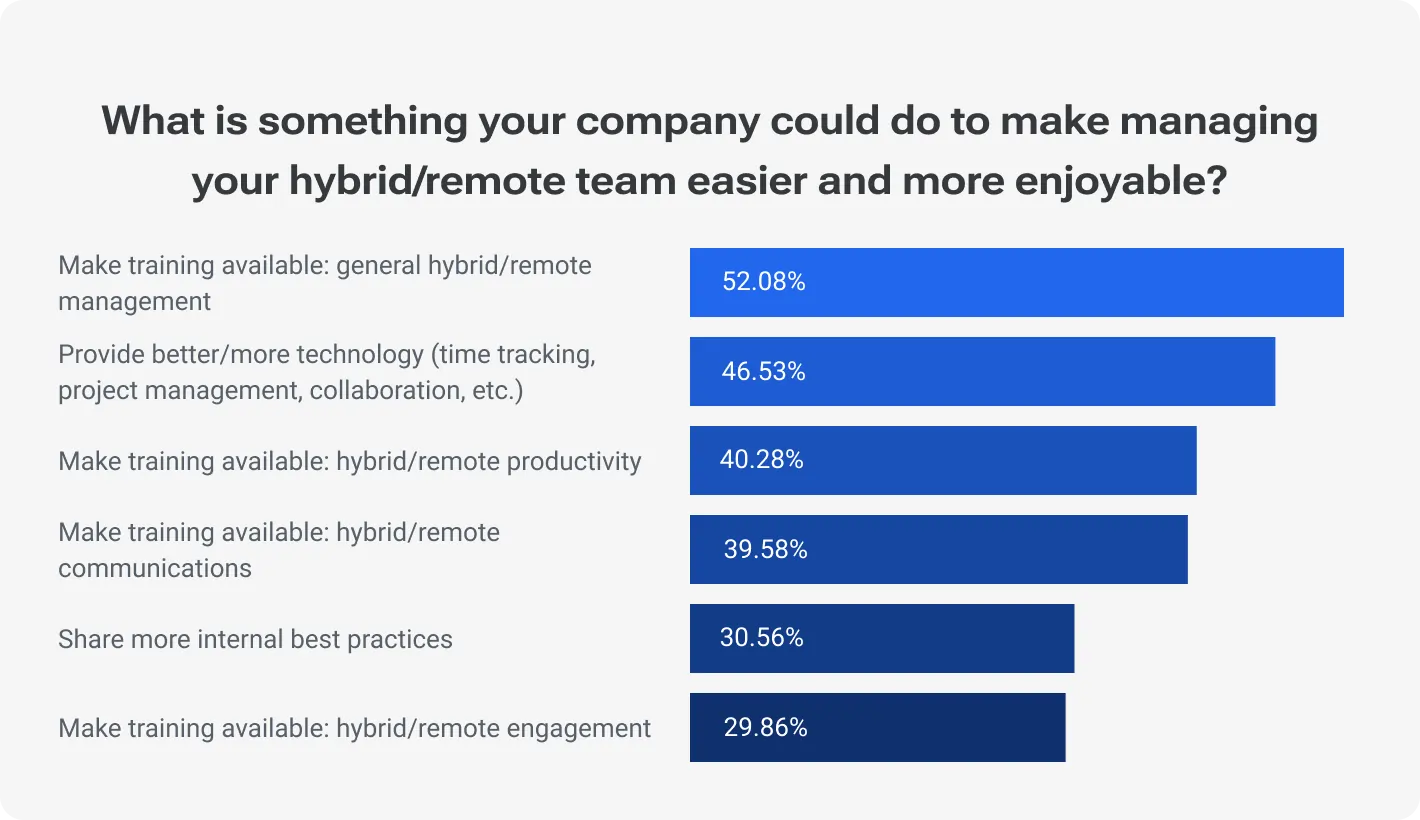
Remote work is not the worst solution for businesses, hands down. However, you must keep the team alert and fast on the uptake. And this is pretty difficult to achieve while WFH. Or not? Below are two top-of-mind tools for understanding cultural peculiarities and managing distributed teams.
Hofstede insights: This tool allows companies to assess cultural differences and prepare management strategies that respect local nuances. If you operate under the employer of record contract, this tool will ease managing teams across diverse regions.
GlobeSmart: An online platform providing resources and assessments to improve team collaboration in a multicultural environment. With it, you get actionable insights that will help you align a corporate culture with a global workforce.
Assess cultural compatibility and embrace emerging trends like remote work, and you will optimize your use of EOR services to achieve both strategic agility and substantial growth.
In wrapping up, embracing an employer of record can significantly simplify how you manage and expand your global workforce. Employer of record agreement implies that EOR handles complex HR tasks (e.g.: payroll, compliance, and benefits administration) across different countries.
This way, your hiring partner allows you to tap into international talent pools without getting bogged down in red tape. This model streamlines operations and opens doors to global markets. According to the mentioned statistics — significantly faster and more efficient than traditional methods.
Devico knows the ropes of integrating an EOR into your business strategy. Yet, actions speak louder than words. That’s why we invite you to a free 1-hour call with our experts. Partner with us and let our experienced team guide you through every step of your international expansion. Reach out today, and let’s explore how our EOR solutions can help elevate your business to new heights.
Outsourcing to Czechia

Dec 2nd 25 - by Devico Team
Find out how much it costs to hire software developers in Czechia in 2025. Compare hourly rates, roles, and factors that impact pricing.
Outsourcing to Czechia

Nov 25th 25 - by Devico Team
Compare Czechia and Poland for software outsourcing in 2025. Discover costs, talent, infrastructure, and which country fits your project best.
Outsourcing to Czechia

Nov 18th 25 - by Devico Team
A complete guide to outsourcing software projects to Czechia, learn about costs, talent, benefits, and how to build successful partnerships in 2025.